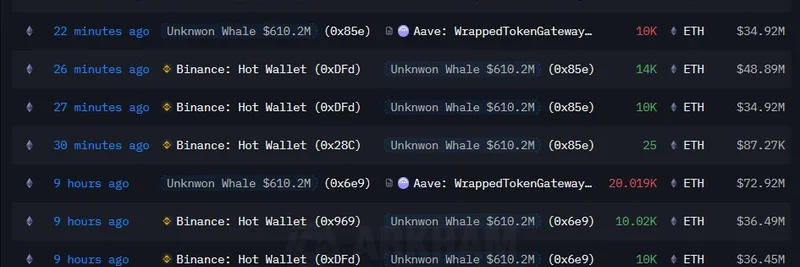In the fast-paced world of cryptocurrency, big players known as "whales" often make bold moves that can influence market trends. A recent example comes from on-chain analyst Onchain Lens, who tracked a whale's strategic short position on Ethereum (ETH), resulting in a hefty $26.9 million profit. This story highlights the power of decentralized finance (DeFi) tools like Aave and centralized exchanges like Binance in executing sophisticated trades.
The Initial Setup: Borrowing ETH on Aave
The whale started by supplying $610.2 million in USDC—a stablecoin designed to maintain a 1:1 value with the US dollar—to Aave V3 as collateral. Aave is a popular DeFi lending protocol where users can lend assets to earn interest or borrow against their collateral.
Using this collateral, the whale borrowed 66,000 ETH when the price was around $4,032 per ETH. They then transferred this borrowed ETH to Binance, likely to sell it on the spot market. This is the essence of short selling: borrow an asset, sell it at a high price, and hope to buy it back cheaper later to repay the loan, pocketing the difference.
At first, as ETH's price dipped to $3,841, it looked like the whale might be facing a $12.6 million loss, according to an earlier update from Onchain Lens. But the story didn't end there.
Turning the Tide: Repaying at a Lower Price
Over the past two days, the whale has been actively repaying the borrowed ETH. They've returned 64,043 ETH, valued at $231.37 million when ETH was trading at about $3,613. This repayment at a lower price than the initial borrow allowed the whale to lock in profits.
After these transactions, the whale still owes approximately 2,022 ETH (around $7.05 million), but the overall short position has yielded a net profit of $26.9 million. It's a classic case of betting against the market—and winning big.
The transfers show a series of inflows and outflows, with the whale moving ETH from Binance hot wallets back to repay the Aave loan. Data from tools like Nansen highlights these movements, labeling the entity as an "Unknown Whale" with a portfolio worth over $610 million.
A Closer Look at the Whale's Positions
On Aave V3, the whale's lending positions reflect the ongoing activity. One wallet shows a supplied balance of about 200 million USDC with a small remaining borrow of 2,021 WETH (wrapped ETH, used in DeFi). Another position has around 190 million USDC supplied and a minimal 0.784 WETH borrowed.
For those curious about the earlier phase, here's a glimpse of the initial transactions, including the supply of USDC and borrowing of ETH.
The Wallets Involved
The whale operates through several addresses, which you can explore on blockchain explorers like Etherscan:
- 0xE5C248D8d3F3871bD0f68E9C4743459C43BB4e4c
- 0x85e05C10dB73499fbDeCAb0dfbB794a446feEeC8
- 0x6e9e81EfCC4CBff68eD04c4a90AeA33cB22c8c89
These moves underscore the volatility in the ETH market and how whales can capitalize on price swings. While this isn't directly tied to meme tokens, such large-scale ETH trades can impact overall market sentiment, potentially affecting the wild rides of meme coins built on Ethereum.
For the full details, check out the original thread on X by Onchain Lens. Stay tuned to Meme Insider for more insights into crypto strategies that could influence your next trade.


